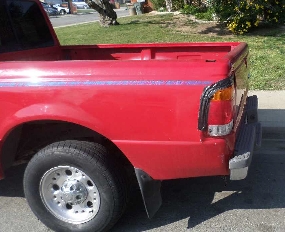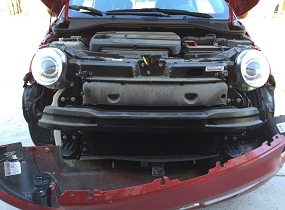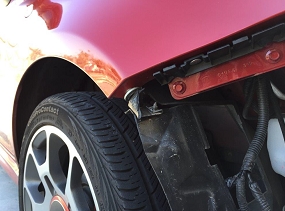The red Fiat and the red Ranger collided. The insured and claimant differed greatly in their stories as to what occurred. The vehicle damage was repaired, and there was no police report. Could we look at photos and tell what really happened? In this case, yes. GEI has a document review program designed for low speed automotive cases like this one, where a physical inspection is impractical or impossible. Typically we are asked:
· Which version of the accident is most probable?
· Could these vehicles have been involved in this accident?
· Is the damage to the vehicles commensurate with this accident?
· What were the speeds, g-forces, and probability for injury in this accident?
We review all of the relevant available documents and form an expert opinion, based upon the supplied documentation. In this case, the insured, driving a Ford Ranger pickup truck stated that the claimant, driving his Fiat 500, squarely rear-ended her vehicle. The claimant insisted that he was in the leftmost lane of two lanes, and the insured vehicle was in the right lane overtaking him. He said the Ford changed lanes to the left across the right front of the Fiat. The left edge of the rear bumper of the Ford hooked on the edge of the Fiat bumper cover and pulled it off the Fiat. The loose bumper cover then pivoted down and scrapped on the pavement until the claimant was able to pull over.
The Ford was a pickup weighing approximately 3,485 pounds. Twelve photographs were presented for our review. The images showed a relatively well-maintained vehicle with no obvious body damage other than to the back left corner area. There was obvious direct contact to the back left body panel where the left bumper corner sat. The vertical height reference showed the rear bumper to sit approximately seventeen to twenty-three inches from the ground. There was an indentation to the sheet metal above the left bumper corner, and the back left tail lamp was taped into place.

The rear bumper was metal. The left bumper corner itself did not show any discernable direct contact, deformation, or damage.
There was no evident direct contact to the rear bumper face, across the width of the back of the vehicle. The far right corner of the bumper appeared to be tilted slightly downward, in relation to the positioning of the left corner. Notably, there was no longitudinal crush to the bumper or evidence of longitudinal compression from the rear, as one might expect from a “square” rear impact from the Fiat.
The Fiat weighed approximately 2,363 pounds, and forty-two photographs were presented for review.
There were photographs of the front with and without the bumper cover in place. The images showed obvious direct contact damage to the front bumper cover. The front plane of the cover had an area of direct contact scratching, right of the center-point. The lowest portion of the cover, being that nearest to the ground, had a black plastic molding piece that was heavily scraped across its width, though predominantly on its left half. The right side of the cover that wrapped around to the right wheel well had direct contact in the form of scratching and fracturing of the plastic.
The portion of the cover wraparound that formed the front of the wheel well was broken. The wraparound on the left side was also slightly cracked. Images of the front with the bumper cover removed show there was no longitudinal crush or deformation to the bumper reinforcement bar or other underlying components. Note that only the bumper cover became dislodged, and not the bumper assembly. Images of the underside of the cover and attachment points showed damage to the brackets that held the cover in place. Notably, the cover did not show any evidence of an impact to the front plane. The overall appearance of the damage suggested an impact where the right side of the bumper cover specifically, the right front wheel well, was struck, and the force pulled the cover forward from its mounting points.
When considering the two versions presented, the Ford did not display direct contact damage to the back plane. There was no longitudinal compression to the bumper, anchors, or body panels. The damage presented was at the far left corner and appeared to be caused by an oblique force, not directly from the rear.
In conclusion, the collision version given by the claimant was the most probable one, and was supported by the photos of the damage to the two vehicles. The red Fiat was the victim, not the cause of the collision.

